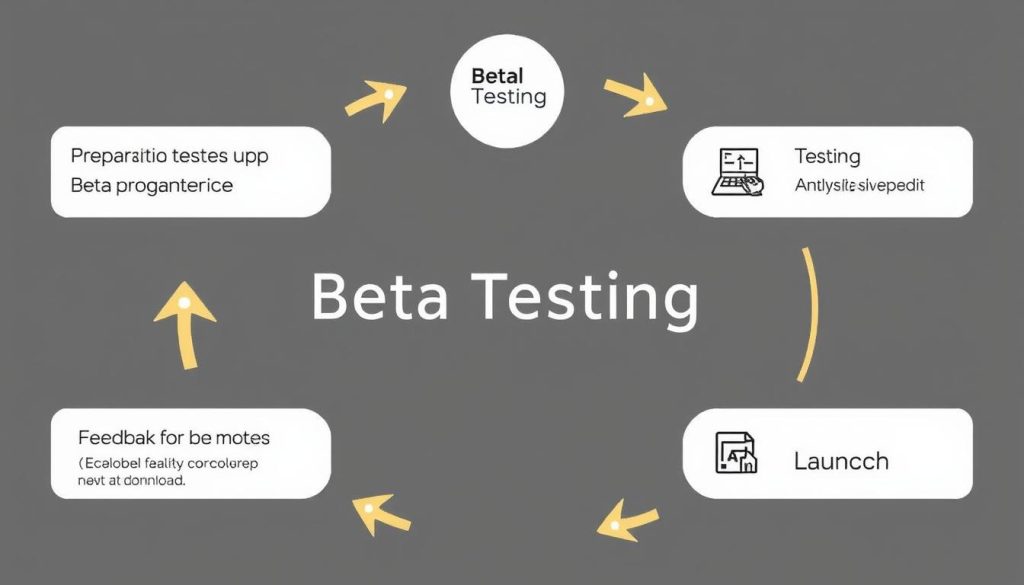Beta testing is vital for successful software launches. It helps gather feedback, spot issues, and refine products before release. This guide explores strategies for promoting beta software to testers.
We’ll cover effective ways to engage the right testers. You’ll learn how to create a smooth path for your product launch.
Key Takeaways
- Understand the significance of beta testing in the software development lifecycle.
- Define your target audience of beta testers to ensure the right feedback is gathered.
- Create a compelling beta testing program with clear goals, expectations, and incentives.
- Leverage social media platforms to effectively promote your beta software to potential testers.
- Build an engaging landing page to streamline the beta tester recruitment process.
Understanding the Importance of Beta Testing
Beta testing is a key phase in software development. It involves testing software with select users before final release. This step is vital for ensuring project success and delivering quality products.
Why Beta Testers are Crucial for Software Development
Beta testers are software development’s unsung heroes. They provide valuable feedback that helps find bugs and usability issues. Beta testers help developers understand how the product will perform in the hands of actual users.
This allows the team to fix problems before the final release. As a result, the user experience improves significantly.
The Benefits of Effective Beta Testing
- Improved product quality: By catching and resolving issues early on, beta testing helps ensure that the final product is of high quality and meets user expectations.
- Reduced post-launch issues: Addressing problems during the beta phase means fewer surprises and headaches for users after the software goes live.
- Increased user adoption: A smooth and bug-free user experience from the start can lead to higher user adoption rates and better customer satisfaction.
- Valuable user feedback: Beta testers provide valuable insights into the product’s functionality, usability, and overall user experience, which can inform future product development and roadmaps.
Beta testing is crucial for software success. It helps companies deliver reliable and user-friendly products. These products better align with their target audience’s needs.
Defining Your Target Audience for Beta Testers
Finding the right target audience for beta testers is vital for your beta program’s success. Knowing your ideal beta tester helps attract valuable and engaged participants.
Consider these factors when defining your target audience for beta testers:
- Technical expertise: Decide what level of tech skills your beta testers need. This could range from early adopters to casual users.
- User behavior: Look at typical user behaviors and pain points. This helps find people who can give useful feedback on usability.
- Industry knowledge: For industry-specific software, target testers with relevant expertise. They can offer insights into unique requirements and challenges.
Careful identification of beta tester demographics creates a diverse tester pool. This ensures comprehensive feedback and meets your target market’s needs.

“Defining your target audience is the key to unlocking the full potential of your beta testing program.”
Creating a Compelling Beta Testing Program
A strong beta testing program is key to attracting great testers. It requires clear goals, expectations, and proper incentives. These elements motivate testers to give high-quality feedback.
Setting Clear Goals and Expectations
Establish clear goals and expectations at the start of your beta testing program. This aligns the development team and beta testers on program objectives.
Consider these key points:
- Defining the specific features or functionalities you want to test
- Determining the timeline and duration of the beta testing phase
- Outlining the feedback and reporting requirements for beta testers
- Establishing clear communication channels and feedback loops
Incentives and Rewards for Beta Testers
The right rewards can boost tester participation quality and quantity. Consider these options:
- Early access to the software – Provide beta testers with a sneak peek at the product before its official launch
- Monetary compensation – Offer financial incentives, such as gift cards or discounts, for completing specific tasks or providing feedback
- Recognition and acknowledgment – Publicly recognize the contributions of top-performing beta testers
- Exclusive perks or features – Grant beta testers access to exclusive product features or special offers
A well-designed beta program with clear goals and attractive incentives attracts dedicated testers. These testers provide valuable insights to improve your software development process.
Leveraging Social Media to Promote Your Beta Program
Social media platforms are powerful tools for promoting beta software. They help reach a wider audience of potential testers. These platforms generate excitement and engage users, securing dedicated beta testers for valuable feedback.
Utilizing Social Media Platforms Effectively
LinkedIn, Twitter, and niche online communities offer unique opportunities to connect with your target audience. Each platform allows you to showcase the benefits of your beta program.
LinkedIn is excellent for reaching industry experts and technical professionals. Share updates about your beta program and highlight its features. Encourage qualified individuals to sign up.
Twitter’s real-time nature helps generate buzz and engage your audience. Share teasers, updates, and behind-the-scenes glimpses of your beta software. Encourage users to participate in the testing process.
Identify relevant online forums or specialized groups where your target beta testers are active. Participate in discussions and answer questions. Introduce your beta program in a genuine and informative manner.
- LinkedIn: This professional social network can be an excellent platform for reaching out to industry experts, technical professionals, and potential beta testers. Share updates about your beta program, highlight the features, and encourage qualified individuals to sign up.
- Twitter: Leverage the real-time nature of Twitter to generate buzz and engage with your audience. Share teasers, updates, and behind-the-scenes glimpses of your beta software, and encourage users to participate in the testing process.
- Online Communities: Identify relevant online forums, subreddits, or specialized groups where your target beta testers are active. Participate in discussions, answer questions, and introduce your beta program to the community in a genuine and informative manner.
Create a consistent and engaging social media presence. Share compelling content and respond to user comments. Actively seek feedback from your audience. A strong social media presence attracts enthusiastic testers.
| Social Media Platform | Key Benefits for Beta Promotion |
|---|---|
| Reach industry professionals, technical experts, and potential beta testers | |
| Generate real-time buzz, engage with users, and share updates about your beta software | |
| Online Communities | Connect with niche audiences and participate in relevant discussions to promote your beta program |

Social media can effectively promote your beta software. It builds a dedicated community of testers. These testers provide invaluable insights to enhance your product’s development.
How To Promote Beta Software To Testers
Finding the right testers for your beta software is key. Good feedback helps ensure a successful product launch. Here are some ways to reach potential beta testers:
Leverage Influencer Relationships
Team up with industry influencers and bloggers. Their audience and credibility can create buzz for your beta software. This partnership can help attract targeted testers to your program.
Optimize Your Beta Landing Page
Design an eye-catching, informative landing page for your beta program. Clearly explain the benefits of joining. Showcase your software’s unique features and the value testers will gain.
| Strategies for Promoting Beta Software | Effective Beta Software Promotion Tactics |
|---|---|
|
|
These strategies can help you promote your beta software effectively. You’ll reach the right testers and gather valuable feedback. This approach leads to a more successful product launch.
Building an Engaging Landing Page for Beta Signups
A well-crafted beta software landing page is key to attracting potential testers. It’s the first step in your beta testing journey. Your page must be visually appealing, informative, and easy to use.
Essential Elements of an Effective Landing Page
Include these key elements when designing your beta software landing page:
- Clear Call-to-Action (CTA): Make it easy for visitors to understand the next steps they need to take to join your beta program. Use prominent, compelling CTAs that encourage sign-ups.
- Detailed Program Information: Provide comprehensive details about your beta testing program, including its objectives, the type of feedback you’re seeking, and the benefits for participants.
- Social Proof: Showcase testimonials, reviews, or success stories from previous beta testers to build trust and credibility with your audience.
- Easy Registration Process: Streamline the sign-up process, requiring only the essential information necessary to join the program.
- Responsive Design: Ensure your landing page is optimized for seamless viewing and interaction across various devices, from desktop computers to mobile phones.
| Essential Element | Description |
|---|---|
| Clear Call-to-Action (CTA) | Make it easy for visitors to understand the next steps they need to take to join your beta program. Use prominent, compelling CTAs that encourage sign-ups. |
| Detailed Program Information | Provide comprehensive details about your beta testing program, including its objectives, the type of feedback you’re seeking, and the benefits for participants. |
| Social Proof | Showcase testimonials, reviews, or success stories from previous beta testers to build trust and credibility with your audience. |
| Easy Registration Process | Streamline the sign-up process, requiring only the essential information necessary to join the program. |
| Responsive Design | Ensure your landing page is optimized for seamless viewing and interaction across various devices, from desktop computers to mobile phones. |
Use these elements to create an engaging beta software landing page. Your page will effectively promote your program and attract interested testers. A well-designed page can boost sign-ups and set your beta testing off to a great start.
Email Marketing Strategies for Beta Tester Recruitment
Email marketing can help recruit and engage beta testers. Compelling subject lines and informative content attract potential testers. Targeted segmentation ensures your message reaches the right audience.
Crafting Captivating Subject Lines
Subject lines make the first impression on potential beta testers. Create attention-grabbing lines that highlight the benefits of your program. Experiment with different formulas, like questions or exclusive information teasers.
Creating Engaging Email Content
Deliver informative and visually appealing content after capturing attention. Provide clear details about your beta testing program. Include information on the product, time commitment, and participation rewards.
Use eye-catching imagery and formatting to make your emails stand out.
Utilizing Targeted Segmentation
Segment your audience based on criteria like industry, job title, or brand engagement. Tailor your content to each segment, ensuring personalized and relevant outreach.
“Effective email marketing is crucial for successful beta testing programs. These strategies help recruit engaged testers who provide valuable feedback.”
These email marketing for beta tester recruitment and effective email strategies for beta testing optimize programs. They drive meaningful participation from targeted potential testers.
Fostering a Strong Beta Tester Community
A thriving beta tester community is vital for your software beta program’s success. Open communication, feedback loops, and tester support are key. These elements drive valuable insights and ensure a successful product launch.
Facilitating Communication and Feedback Loops
Effective communication is crucial for a successful beta tester community. Set up various channels for testers to share their experiences and suggestions. This could include online forums, virtual meetups, or in-person events.
Make it simple for testers to provide feedback on functionality and user experience. Encourage open dialogue about any issues they encounter. This approach will help identify and address problems quickly.
Show testers you’re listening by implementing clear feedback loops. Update the community regularly on software development progress. Acknowledge their contributions and highlight how their input shapes the product roadmap.
- Establish multiple communication channels for beta testers to share feedback
- Encourage open dialogue and make it easy for testers to provide input
- Implement clear feedback loops to demonstrate that you’re listening and acting on the community’s suggestions

By building a beta tester community and facilitating beta tester communication and feedback, you’ll enhance your software’s quality. You’ll also create loyal advocates who’ll support your product long after testing ends.
Analyzing and Implementing Beta Tester Feedback
Beta tester feedback is vital for software development. It helps refine and enhance your product. By reviewing input, you can create a more polished and user-friendly final product.
Start by organizing feedback into categories. Look for common themes and recurring issues. This helps prioritize the most important changes to focus on.
Identify frequent bugs and pain points. Analyze user feedback to understand the overall experience. Assess the impact of implementing suggested changes.
- Identify the most frequently reported bugs or pain points.
- Analyze user feedback to understand the overall user experience and areas for improvement.
- Assess the feasibility and impact of implementing the suggested changes.
After gathering key insights, it’s time to start implementing beta tester feedback. Focus on changes that improve functionality, usability, and user satisfaction. This may involve updating design, interface, features, or technology.
| Feedback Insight | Proposed Implementation | Expected Impact |
|---|---|---|
| Confusing navigation menu | Simplify the navigation structure and improve labeling | Enhanced user experience and increased engagement |
| Compatibility issues with older devices | Optimize the software for better performance on older hardware | Expanded user reach and increased accessibility |
| Requests for additional features | Develop and integrate the most requested features | Increased user satisfaction and competitive advantage |
Keep iterating and refining your software based on beta tester insights. Analyzing beta tester feedback and implementing impactful changes creates a product that meets user needs.
Best Practices for Managing Beta Testing Cycles
Managing beta testing cycles is vital for a successful beta program. Clear timelines, efficient feedback collection, and optimized workflows are essential. These best practices ensure a smooth beta testing experience.
Streamlining the Beta Testing Process
Here are some effective strategies to streamline the beta testing process:
- Set Realistic Timelines: Create a clear timeline for the beta testing cycle. Allow enough time for feedback collection, bug fixes, and updates. Avoid rushing to ensure thorough testing.
- Implement Efficient Feedback Channels: Offer multiple ways for beta testers to submit feedback. Use online forms, in-app reporting, or dedicated email addresses. This captures all valuable insights efficiently.
- Prioritize Feedback and Bugs: Develop a system to rank the importance of feedback and bugs. Address the most critical issues first for a smooth product launch.
- Optimize Communication: Keep in touch with beta testers regularly. Provide updates on bug fixes, feature changes, and overall progress. This builds trust and encourages engagement.
- Automate Processes: Use tools to streamline bug tracking, feedback collection, and workflow management. This reduces manual effort and ensures efficient data processing.
These practices enhance the quality of your beta program. They help gather valuable insights for final product development. Implementing them improves best practices for beta testing cycles.
Using these strategies aids in streamlining the beta testing process. This leads to better product outcomes and a more successful launch.

“Efficient beta testing is the key to launching a successful product. By streamlining the process, you can maximize the value of your beta program and drive better product outcomes.”
Conclusion: The Key to Successful Beta Software Promotion
Promoting your beta software to the right testers is vital for a successful product launch. This guide has explored key strategies to reach and engage your target beta testing community.
Understanding your audience’s needs and preferences is crucial. Define your target testers and create a compelling program with clear goals and incentives. This approach will attract the right individuals to provide valuable feedback.
Use social media platforms to amplify your beta software promotion. Build an engaging landing page and implement strategic email marketing campaigns. These techniques will help you reach a wider pool of potential testers.
Foster a strong beta tester community to drive engagement. Facilitate ongoing communication and feedback loops. These steps are essential for gathering actionable insights from your beta testing process.




